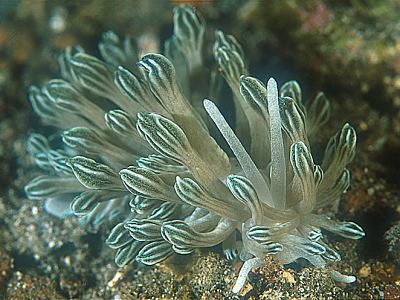
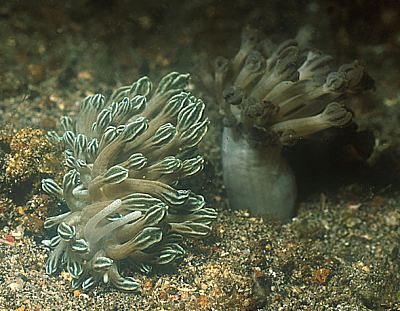
Phyllodesmium rudmani
Burghardt & Gosliner, 2006
Order: NUDIBRANCHIA
Suborder: AEOLIDINA
Family: Glaucidae
DISTRIBUTION
At present known only from the Philippines and northern Indonesia
PHOTO
Lembeh, North Sulawesi, Indonesia. December 2002. Upper: Stephen Wong. Lower: Takako Uno
This solar-powered aeolid is a remarkable mimic of the Xenia colonies on which it feeds, often nestling in cavities it has burrowed out in the base of the colony.
The body and smooth rhinophores are a translucent white with some white dusting especially near the tips of the rhinophores and oral tentacles. The cerata have a cylindrical trunk which widens out at the tip to form a swollen region with longitudinal ridges and deep grooves. Each ceras mimics the shape of a Xenia polyp with retracted tentacles. The ceratal trunk is translucent white except at the swollen tip where the ridges are white and the grooves are green or brown, apparently depending on the colour of the Xenia being eaten. The green and brown colour is from the symbiotic zooxanthellae being which are kept in terminal sacs of the digestive gland, which occur only at the tips of the cerata.
No branches of the digestive gland are found in the body wall or in the trunk region of the cerata. A single digestive gland duct runs up the centre of the trunk region, only branching when it reaches the swollen tip.
NOTE: This species was previously known on the Forum as Phyllodesmium sp. 11
-
Burghardt, I. and Gosliner, T. M. (2006) Phyllodesmium rudmani (Mollusca: Nudibranchia: Aeolidoidea), a new solar powered species from the Indo-West Pacific with data on its symbiosis with zooxanthellae. Zootaxa, 1308: 31-47.
Rudman, W.B., 2007 (February 17) Phyllodesmium rudmani Burghardt & Gosliner, 2006. [In] Sea Slug Forum. Australian Museum, Sydney. Available from http://www.seaslugforum.net/find/phyllodrudm
Related messages
Juvenile Phyllodesmium rudmani from Red Sea
March 3, 2008
From: Michael Henke
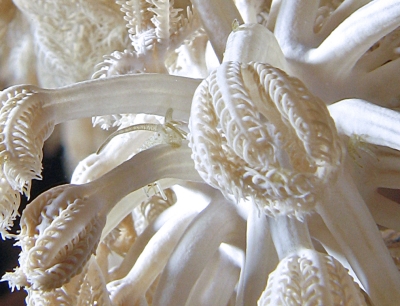
Sorry Bill,
The subject must be for you like: "The world is a disk", but maybe it's true and than it is interesting for you. I only have this one bad picture, but one bad is better than none.
Locality: Mangrov Bay, 8 m, Egypt, Red Sea, 13.11.07, Xenia umbellata. Length: 4 mm. Photographer: Michael Henke.
Regards
Michael
henke@seddoc.de
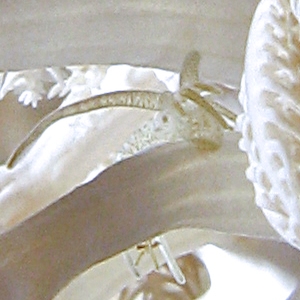
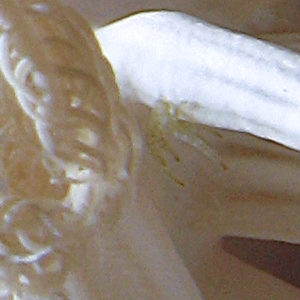
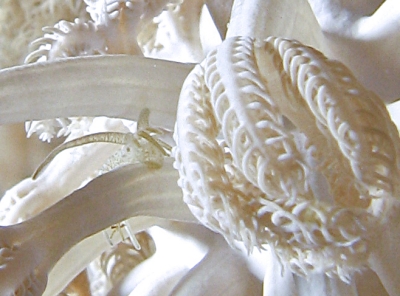
Dear Michael,
Certainly the one just left of centre in your photo looks like the head of an aeolid with long slender rhinophores and a large eye, but I am afraid the 'fringe' of little tentacles around the front end show it isn't an aeolid. My guess is that the 'eye' spot is just a dark spot and these little objects are small sea anemones. Unfortunately when you only have photographs to examine you cant give mysterious objects a gentle little poke to see what they will do - or how they crawl.
Best wishes,
Bill Rudman
Phyllodesmium rudmani from Nth Sulawesi
March 20, 2007
From: Michael Pollack
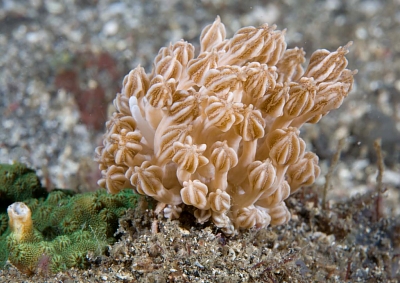
Hi Bill,
I didn't believe this was a nudibranch at first, but my Lembeh Resort dive guide was very persistent. I don't even know where to start (family-wise) with this identification. Any help would be greatly appreciated.
Locality: Lembeh strait, Approximately 6 meters, North Sulawesi, 16 November 2006, Muddy. Length: 2 inches. Photographer: Michael Pollack.
Thanks in advance,
Michael
michael@untamedimages.com
Pollack, M., 2007 (Mar 20) Phyllodesmium rudmani from Nth Sulawesi. [Message in] Sea Slug Forum. Australian Museum, Sydney. Available from http://www.seaslugforum.net/find/19688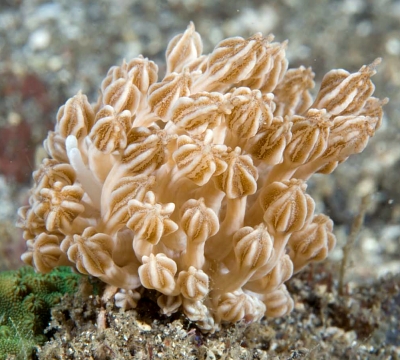
Dear Michael,
I can understand your hesitation in thinking this is a nudibranch. It looks for all the worls like a colony of a xeniid soft coral. The clue to its identity are the two white tentacles on the left of the animal, in your photo. They are the rhinophores, or head tentacles, of an aeolid nudibranch Phyllodesmium rudmani which has only recently been named. Have a look at the species Fact Sheet, and earlier messages, for more information on this species.
Best wishes,
Bill Rudman
New species - Phyllodesmium rudmani
February 17, 2007
From: Ingo Burghardt
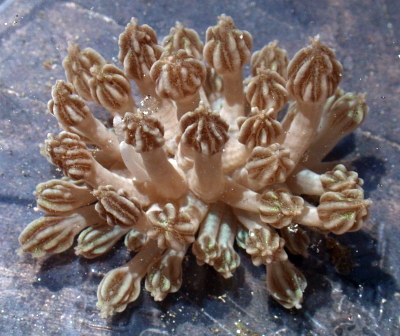
Dear Bill,
You know it already, but not the seaslug "community": Terry Gosliner and I have recently described the "solar-powered" Phyllodesmium species formerly known on the Forum as "Phyllodesmium sp.11". We have named it after you - Phyllodesmium rudmani - in order to express our gratitude. Thanks for being a pioneer in working on "solar-powered" nudibranchs and thanks for creating and maintaining the great Sea Slug Forum! :-)
Locality: Bunaken Island, 1 m, Indonesia, Pacific Ocean, July 2003, patchy coral reef. Photographer: Michael Schrödl.
Best wishes,
Ingo
ingo.burghardt@rub.de
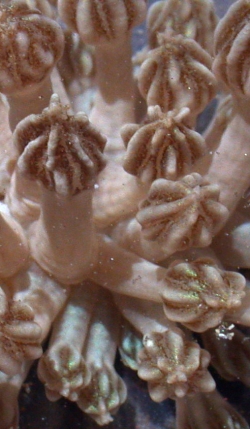
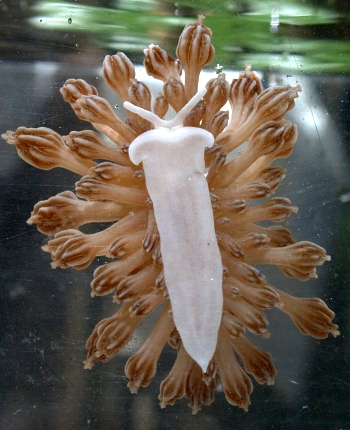
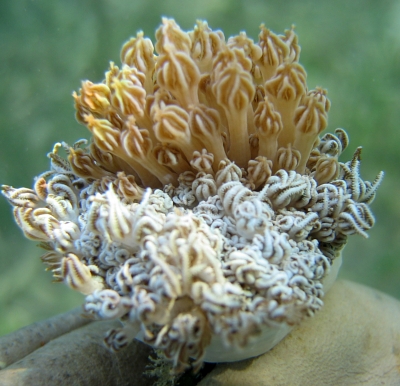
Dear Ingo (& Terry),
Thanks very much. These solar powered slugs have been a special research interest of mine for many years so it means a lot to me to have one named after me. When Takako Uno & Stephen Wong sent photos of this species to the Forum [message #9200] five yeasr ago, I was just about to leave to give a course on molluscs at a local university. I was so impressed by this animal and its mimicry of Xenia that I sat down and remade my Power Point presentation to include this remarkable animal.
As you mention in your description, the cerata of this species are not flattened like those of other Xenia- feeding species but circular, and the zooxanthellae are restricted to the upper ridged part of the cerata where they are in full sunlight. Although they don't realise it, they not only mimic a Xenia polyp in shape, but also in where they keep their zooxanthellae, for in Xenia I found that the vast majority of the zooxanthellae are stored in sacs along the polyp tentacles [see zooxanthellae in cnidarians ]
The work you are doing with your Diving PAM (Pulse Amplitude Modulated Fluorometer) has opened up an exciting new window into how these solar-powered animals operate. Amongst the Forum backlog there are many Phyllodesmium messages, so I have decided to turn today into 'Phyllodesmium Day' and post just messages on this wonderful genus. Some of the messages have been waiting a while - but just think of them as having time to mature, like a good red wine.
Best wishes,
Bill Rudman
Phyllodesmium sp. 11 from Lembeh strait
December 19, 2005
From: Heidi Hösel
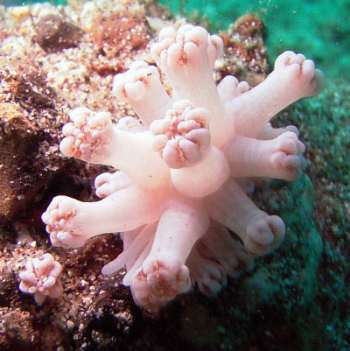
Two specimens of this this Xenia-colony mimicking nudibranch have been found in Lembeh strait, North-Sulawesi at the dive site Pantai Parigi at about 6 m depth in between Xenia colonies. The sizes were about 3 cm for the bigger and about 1 cm for the smaller specimen.
It seems that this nudibranch can actively detach at least the upper part of its cerata which in colour and shape very closely mimic contracted Xenia polyps (see upper photo, left of the specimen. I wonder whether this could belong to the genus Phyllodesmium?
Locality: Lembeh strait , Indonesia, North Sulawesi. Depth: about 6 m. Length: ca. 3 cm /1 cm. 26 August 2005. in betweeen Xenia colonies. Photographer: Heidi Hösel
Heidi Hösel
hhoesel@gmx,de
Hoesel, H., 2005 (Dec 19) Phyllodesmium sp. 11 from Lembeh strait. [Message in] Sea Slug Forum. Australian Museum, Sydney. Available from http://www.seaslugforum.net/find/15499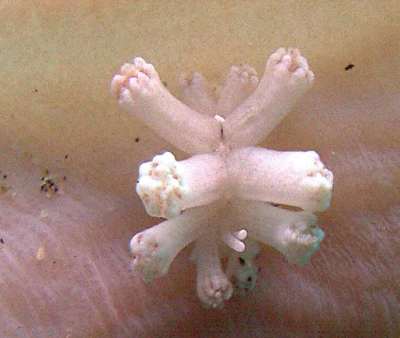
Note added 17 February 2007: This species has now been named Phyllodesmium rudmani.
Dear Heidi,
Yes this is a species of Phyllodesmium. I suspect it is the one I have on the Forum as Phyllodesmium sp. 11. Although species of Phyllodesmium do break off their cerata as a defensive strategy [see autotomy page] I don't know of a species which just breaks off the tip as you suggest. Is it possible the object to the left of the nusibranch is a small single polyp of Xenia? Colonies of Xenia start as a single small polyp.
Best wishes,
Bill Rudman
Re: Phyllodesmium sp - another Xenia mimic
March 28, 2003
From: Erwin Koehler
Hi Bill,
May be of some interest: one more shot of this one is at Mike Miller's site [http://slugsite.us/bow/nudiwk05.htm] from Batangas, Philippines. Phil Slosberg had some of them at his website, but they are no longer there.
Erwin
Erwin@medslugs.de
Note added 17 February 2007: This species has now been named Phyllodesmium rudmani.
Thanks Erwin,
I had forgotten it - I think my brain sometimes mimics a sponge
Bill Rudman
Re: Phyllodesmium sp. 11
March 22, 2003
From: Nerida Wilson
Hi Bill,
I recall seeing a note reporting this Xenia mimic from Bali.
• Soft coral mimensis by an aeolidiid nudibranch. Coral Reefs (2001) 20: 66.
Best wishes
Nerida
nwilson@marine.uq.edu.au
Wilson, N., 2003 (Mar 22) Re: Phyllodesmium sp. 11. [Message in] Sea Slug Forum. Australian Museum, Sydney. Available from http://www.seaslugforum.net/find/9432Note added 17 February 2007: This species has now been named Phyllodesmium rudmani.
Thanks Nerida,
An author perhaps?
Cheers,
Bill
Phyllodesmium sp - another Xenia mimic
March 17, 2003
From: Takako Uno & Stephen Wong
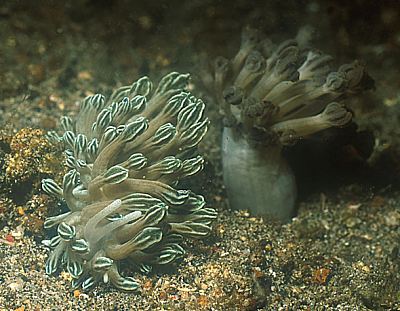
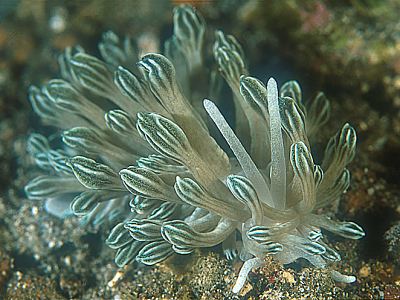
Dear Dr. Rudman,
Excuse us for constantly troubling you. My husband, Stephen, and I saw this nudibranch (with the help of a super-eyed-divemaster) on our Dec 2002 trip in Lembeh, N.Sulawesi Indonesia.
It looks like the organ pipe coral (Tubipora or Clavularia or Xenia) in the upper photo. It really was difficult to see it, when we took our eyes off it. The interesting nudi just blended perfectly with these same sized corals. A bigger photo by Stephen shows its oral tentacles.
We have checked with all our literature at home, but can not locate it nor anything close. Can you kindly help us with this species?
Upper: Takako Uno
Lower: Stephen Wong
Best regards,
Takako Uno & Stephen Wong
divetoto@hotmail.com
Uno, T. & Wong, S., 2003 (Mar 17) Phyllodesmium sp - another Xenia mimic. [Message in] Sea Slug Forum. Australian Museum, Sydney. Available from http://www.seaslugforum.net/find/9200Note added 17 February 2007: This species has now been named Phyllodesmium rudmani.
Dear Takako & Stephen,
What a wonderful animal! You have my permission to continue to constantly trouble me with photos like this. Your photos arrived just as I was leaving to take part in a mollusc course at one of our local universities. I hope you don't mind but I just had to include them in one of my talks, as an example of perfect camouflage and possibly Solar Power, and also as an example of all the amazing new information that participants to the Sea Slug Forum are making available to us all.
This is a species of Phyllodesmium and I assume it is unnamed. I am pretty sure the soft-coral it is mimicking is a species of Xenia. It has similarities to Phyllodesmium kabiranum which sometimes has white lines on the upper part of the cerata but we would need to find some intermediates, and compare their anatomy to be sure. At present I will call it Phyllodesmium sp. 11.
Best wishes
Bill Rudman
